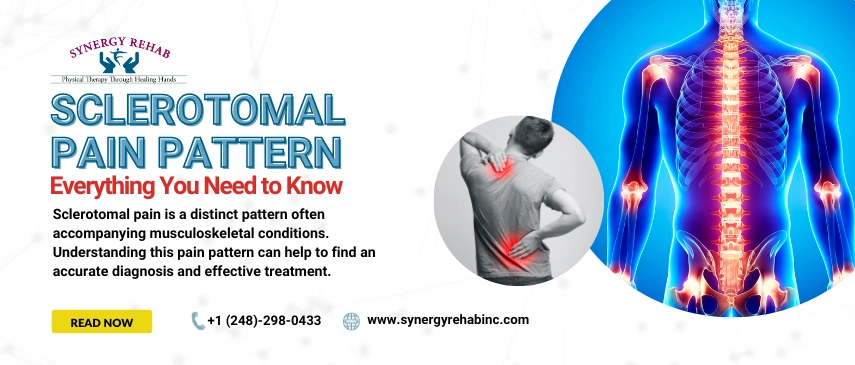Pain, an unwelcome sensation, manifests in various forms, each with unique characteristics and patterns. Among these, sclerotomal pain is a distinct pattern often accompanying musculoskeletal conditions. Understanding this pain pattern can help to find an accurate diagnosis and effective treatment.
Image Source: AcupunctureProducts.com
Sclerotome: A Hidden Pain Pathway
You must first understand the spinal cord and its segments to understand sclerotome pain patterns. The spinal cord is divided into different levels associated with specific nerves. Sclerotomes are parts or tissues of the body that share a common nerve root.
When there is irritation or dysfunction in these tissues, you can experience a referral pain pattern known as a sclerotomal pain pattern. This pain can result from various factors, including injuries, inflammation, or degenerative conditions. The pain may be experienced locally at the site of the issue or radiate to other areas connected by the same nerve pathway.
Symptoms of Sclerotomal Pain
A deep and dull ache that can be felt in various body parts is one of the most common symptoms of sclerotomal pain. Other symptoms may include
- Numbness or tingling
- Sensitivity to touch
- Burning sensations in the muscles, tendons, and bones supplied by the affected nerve root.
- Referred distribution
- Muscle stiffness or weakness
Image Source: Regenerative Spine and Joint Centre
Identifying Sclerotomal Pain Patterns
Different spinal nerves are associated with distinct sclerotomal regions, leading to characteristic pain patterns.
| Cervical Sclerotomes (C1-C8) | |
| C1-C2 | Pain in these segments may lead to headaches and neck pain. |
| C3-C4 | Pain may radiate to the shoulder and upper arm |
| C5-C6 | Pain might spread down the lateral arm and into the thumb and index finger |
| C7-C8 | Pain can travel down the arm into the middle fingers |
| Thoracic Sclerotomes (T1-T12) | |
| T1-T4 | Pain might occur in the upper chest and upper back |
| T5-T8 | Pain can manifest around the ribcage and upper abdomen |
| T9-T12 | Pain may spread to the lower abdomen and flanks |
| Lumbar Sclerotomes (L1-L5) | |
| L1-L2 | The pain can radiate into the groin and hip |
| L3-L4 | Pain might manifest in the front of the thigh and knee |
| L5 | Pain may extend down the front of the leg |
| S1-S3 | Pain can radiate in the back of the leg and foot |
Causes of Sclerotomal Pain
Identifying the exact cause of sclerotomal pain is difficult because various reasons can contribute to it, including:
Herniated Disc: When the soft inner core of the spinal disc bulges or ruptures, it can irritate the nerve root, resulting in sclerotomal pain.
Degenerative Disc Disease: Degenerative changes in the spine, including bone spurs and spinal canal narrowing, can compress nerve roots, resulting in sclerotomal pain.
Image Source: Mayo Clinic
Osteoarthritis: Osteoarthritis is a degenerative joint disease that can affect the spinal joints, causing pain and inflammation in the bones and joints.
Trauma: Trauma to the spine, such as from a car accident or fall, can damage spinal nerve roots and cause sclerotomal pain.
Infection: Spine infection can also damage spinal nerve roots and cause sclerotomal pain.
Diagnosis of Sclerotomal Pain
Diagnosing sclerotomal pain can be challenging because it is diffused in nature and overlaps with other nerve pain patterns. However, with a thorough physical examination and imaging studies, your therapist can identify the root cause and prescribe the best treatment approach.
- Clinical Assessment: Physical therapists often start with a thorough clinical examination, including evaluating your symptoms and pain pattern to identify sclerotomal involvement.
- Medical Imaging: X-rays, MRIs, and CT scans can provide detailed images of the spine, helping to identify structural abnormalities contributing to sclerotomal pain.
Treatment Approach: Physical Therapy
Understanding the exact cause of sclerotomal pain can help medical professionals determine the compromised treatment approach. One of the effective sclerotomal pain pattern treatment options is physical therapy.
Image Source: Healthline
Physical therapy can help to:
- Reduce pain
- Improve muscle strength
- Increase flexibility
- Reduce future pain incidents
Your physical therapist may prescribe the following exercises based on the severity and cause of the pain:
- Strengthening Exercises: Strengthening exercises, including planks and bridging, will help strengthen the muscles that support your spine, which can help to reduce pain and improve your posture.
- Stretching Exercises: Stretching will help to improve flexibility and range of motion. These exercises may include hamstring stretch, calf stretch and neck stretch.
- Aerobic Exercises: Aerobic exercises, including walking, swimming, and cycling, can help improve your overall fitness and cardiovascular health, which can help reduce pain.
- Balancing Exercises: These exercises help to improve your posture and balance by strengthening your muscles in the core.
If you are dealing with chronic pain but don’t know the exact cause, it’s the right time to approach a physical therapist at Synergy Rehab for your proper diagnosis and timely treatment. With our easiest physical therapy approach, you can get rid of your sclerotomal pain. So, why wait? Schedule your consultation now!



